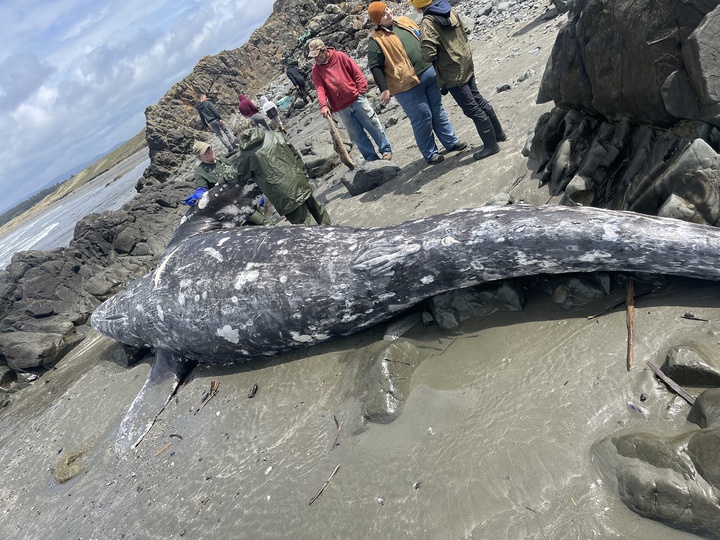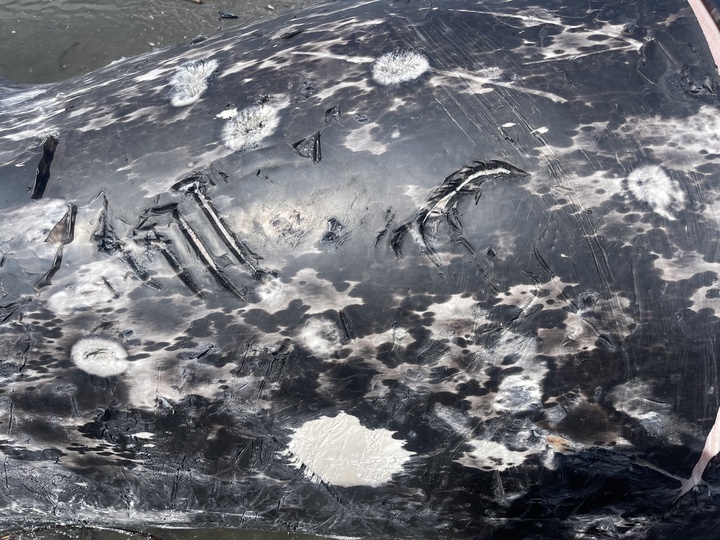Jessica Cejnar Andrews / Thursday, April 20, 2023 @ 12:45 p.m. / Animals, Environment, Ocean
Dead Gray Whale Near Point St. George May Have Been Attacked by Orcas

A 28-foot gray whale that washed ashore near Point St. George recently may have been involved in an orca attack over the weekend. | Photo courtesy of Harry Adams
A dead gray whale that washed ashore near Point St. George recently may have been at the center of an orca attack Cal Poly Humboldt researchers and a local whale watching guide witnessed on Saturday.
The 28-foot animal had fresh tooth marks on its body, said Dr. Dawn Goley, director of Cal Poly’s Marine Mammal Stranding Program, though she and her students didn’t see obvious signs of fatal injuries.
Goley and her students heard about the dead gray whale on Tuesday and traveled to Del Norte to investigate. The animal, probably a juvenile, was fairly emaciated — which isn’t unusual for the time of year. They completed an external and internal investigation, but were unable to determine a “definitive cause of death,” Goley told the Wild Rivers Outpost on Thursday.
Though the whale’s death is a mystery, it is directly linked with a killer whale attack that occurred a few days before it stranded, Goley said.
“It was just north of Castle Rock in that little cove in there,” she said. “It’s exactly the right location. In fact, I’m a little surprised not to see more obvious signs of killer whale attack.”
Crescent City Harbor Commissioner Harry Adams, owner of charter business Stella's Adventures, was on the water with a group of clients not far from the Cal Poly researchers on Saturday. They were watching two adult gray whales and a smaller whale when one of his passengers shouted, “Orcas!”
“Here’s five orcas swimming at 35 m.p.h. straight at these whales,” Adams told the Outpost. “They’re flying! As soon as they get close, four of them break off and go (for the ) calf while the big female goes after the two adults (grays).”
Adams said he was about a mile and a half to 2 miles off shore in the rocky St. George Reef area when the attack occurred. He estimated the water to be about 80 feet deep when the orcas began harassing the gray whales. The orcas drove the smaller gray whale into about 38 feet of water before abandoning the attack, Adams said.
“It was non-stop,” he said, adding that he spoke with a scientist who researches orcas. “They were working (the gray whale) like a ferris wheel — going around with a different orca every second flipping it on its back trying to drown it.”

Cal Poly Humboldt Professor Dawn Goley said there were signs of orca attack on the whale's body, though no definitive fatal injuries. | Photo courtesy of Harry Adams
Josh McInnes, an orca researcher from the University of British Columbia’s Marine Mammal Research Unit in Vancouver, said Adams described a common hunting practice when it comes to orca predation on gray whales.
As they migrate up the West Coast, gray whales often feed in shallow water and kelp beds. They’re more vulnerable in deep water, which orcas seem to realize, McInnes said. During these hunts, which can last 1 to 5 hours, killer whales target gray whale calves that were born three to four months prior and are weak and vulnerable, he said.
“The big goal is getting the calf away from its mother,” McInnes told the Outpost. “We often observe killer whales trying to use their bodies to move calves away. They grab onto the tail fluke of calves or their pectoral fins trying to drag the calf away. Once the calf is separated, killer whales change their behavior to try to wound it. We often see them ramming it.”
Orcas, which can weigh 8,000 to 15,000 pounds, target the calf’s head, ramming into it at about 12-18 miles per hour, McInnes said. The gray whale can’t raise its head out of the water to take a breath and often drowns.
“It’s like being hit with a Ford F150. They deliver devastating blows,” he said.
Though he hasn’t yet seen the necropsy, McInnes said it sounded like the gray whale that washed ashore in Crescent City was already weak due to being malnourished and was trying to gain energy in a common feeding area. The orca hunt was unsuccessful because it occurred close to shore, McInnes speculated.
“By that time the gray whale had already been injured from the attack and the killer whales abandoned the hunt and the gray whale died of its injuries and washed up on shore,” he said. “If an animal is already emaciated — and we do see this in gray whales — we don’t see wounds that kill the animal, but if it’s already emaciated and super stressed, we don’t know, but (the attack) could cause some sort of adverse reaction the animal could die of.”
McInnes said photos he had seen of the whale carcass showed rake marks where the orcas had raked their teeth on its body. However, it would be difficult to determine what kind of internal damage the gray whale took from the attack, he said.
Goley said she and her students left the gray whale carcass on the beach to return to its natural cycle. The decomposing body is an important source of nutrients to the near-shore ecosystem and can be recycled through scavengers on land and at sea, she said.
While it’s normal for gray whales to be traveling through the Crescent City area at this time of year and for killer whales to attack them, Goley urged people to call Cal Poly’s marine mammal stranding hotline at (707) 826-3650 if they do find a stranded animal.
Beachgoers can also call the Northcoast Marine Mammal Center at (707) 465-6265 for injured marine mammals, Goley said.
Adams, who was a commercial fisherman before he began his charter business, is now a self-professed whale nerd. While the attack he and his clients witnessed on the gray whale might have been disturbing, Adams said it was a once-in-a-lifetime experience.
“I partied a lot in the '80s and this is like no other friggin’ high in the world,” he said. “It’s a natural adrenaline rush!”
CLICK TO MANAGE